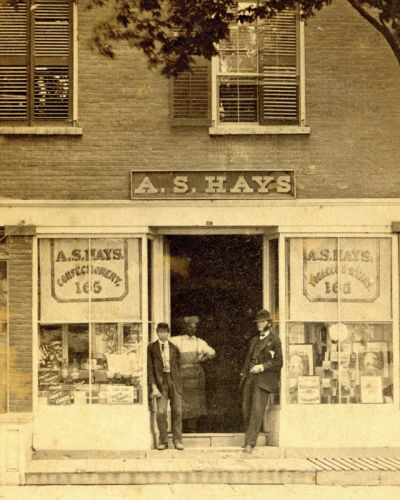
Written by Field Horne | curators Ruby Marcotte & Susan McGrath
During work on the vast archive of the Saratoga Springs History Museum in 2016, a group of fifteen mounted photographs of Broadway businesses turned up in a box of random papers. There was no clear evidence of their provenance, but they may have been collected by photographer George S. Bolster (1913–1989). They carry no photographer’s stamp but a handwritten legend on one mount suggests they were taken by Patrick H. McKernon.
Born in Ireland about 1829, McKernon was in Saratoga Springs by 1860 when he was called an “artist.” In 1867 a reporter noted he “did a small business” and was considered honest; in the following year he had a studio at 130½ Broadway. The site is now 378 Broadway, occupied by the Funding Store. By 1876 he had moved to Fort Edward, but soon returned to Saratoga Springs.
The photographs provide us with an unparalleled look at the quotidian act of shopping in post-Civil War Saratoga Springs. From internal evidence we know they were taken in 1867 or 1868. All the businesses save one advertised in the Weekly Saratogian and/or the street directories. Many details were obtained from the R.G. Dun Credit Reporting Ledgers in the Baker Library, Harvard Business School, Boston.
1. L.L. Brintnall Groceries and Provisions 220 Broadway [now 472, Menges and Curtis]
Lorenzo L. Brintnall (c.1834–1890) came from Townshend, Vermont, opening his grocery store in the spring of 1867.
Later in life he ran the Waverley Hotel, a flatiron-shaped structure at North Broadway and the present Arterial.
On the building’s upper floors was the furniture warehouse
of George K. Krigger (1831–1889). By 1880 Krigger had removed to Chicago.
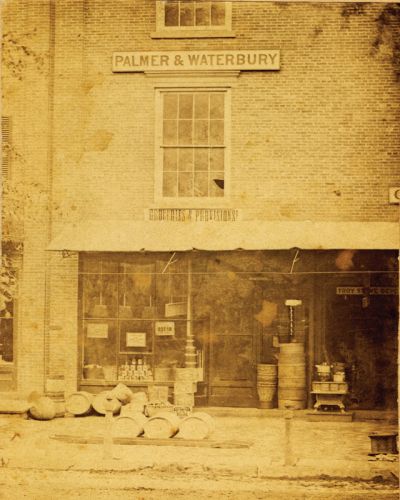
3. F.W. Fonda & Co., Dealers in staple and fancy dry goods 200 Broadway (Now 436, Lifestyles)
Saratoga native Ferdinand Wiggins Fonda (1839–1919) was in business by the late 1850s but in 1861 speculated in oil, losing big within a year, so he sold out to Wescott and Smith in 1863. By 1867 he was back in business and in 1874 was “doing the best business in town.” He later moved to New York City and died there.
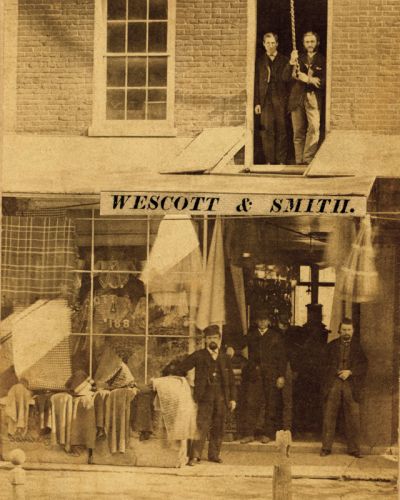
5. Joseph G. Cooke, Hardware, Tin and Stoves 166 Broadway (Now 404, n. Fox Jewelers)
Joseph Gardiner Cooke (1834–1886) was a native of Milford, Otsego County, and was brother-in-law of prominent Saratogian Charles S. Lester, president of the Commercial National Bank. In 1867 Cooke bought out his partner Henry R. Benedict; in the following year he bought the businesses of both Benedict and Terwilliger and knocked out a wall combining two storefronts. He was reported to be a “good businessman, the best hardware dealer in Saratoga Springs,” with net worth of $44,000 in 1874, equivalent to $1.25 million today. He erected a new building in 1873 but between 1875 and 1880 moved to Washington, D.C., where he died.
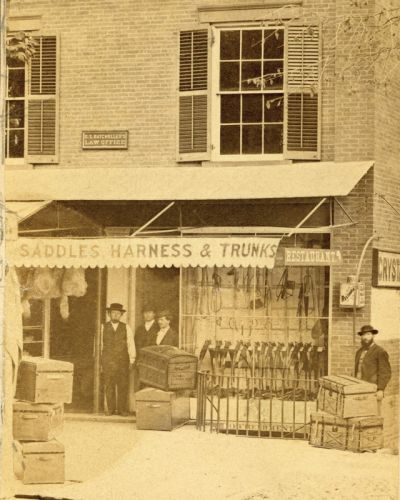
7. D.M Mcmaster, boots, shoes & rubbers. 176 Broadway (Now 410 Cantina)
David M. McMaster (b. ca. 1827), from Geneva, Ontario County, had been a canal captain, but opened his Broadway store shortly before March 1863. In 1870 he was reported to be “well insured and not overstocked.” His rubber boots were a relatively new invention, developed by Hiram Hutchinson after he bought the use of Charles Goodyear’s patent for vulcanizing (hardening) rubber in 1853.
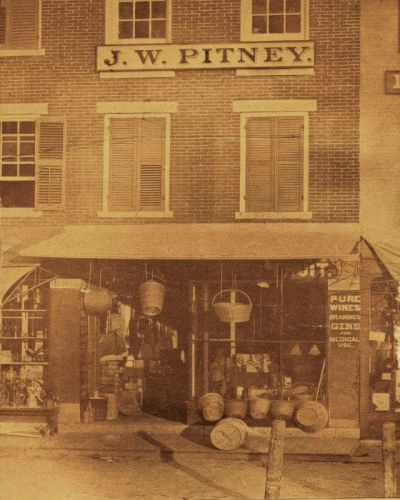
9. E.W Ouderkirk Furniture and Upholstery. 171 Broadway ( Now 431, Putnam Market)
Edward W. Ouderkirk (1831–1874) started his business around 1863, described in 1866 as “a small trade.” He was reported as “character and habits good but has a crazy wife.” He took a new “stand” in 1869. Later “occasional sprees” were reported, but under-insured, he lost thousands in an 1872 fire.
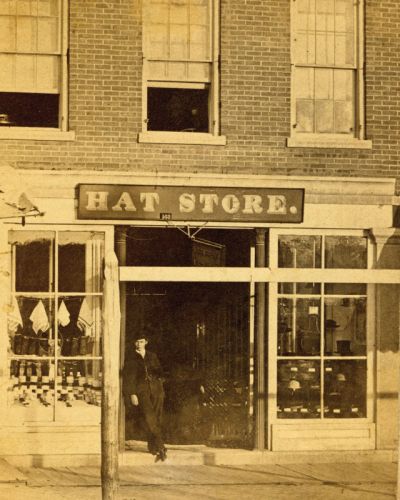
11. C.R Brown Jewerler and Optician. 71 Broadway ( Now 297, Vision Center)
Charles R. Brown (1843–1882) came from Otsego County in 1859 and was soon in business selling jewelry and fancy goods and repairing watches. He also operated the Park House but was burned out in 1864. Brown was a “cripple” and “goes about town in a velocipede,” a primitive bicycle that operated like a scooter with a seat. By 1869 he owned an entire business block on Broadway. In 1871 he built the Park Place Hotel but it burned soon after the season ended. The following year he built a new hotel, the massive Grand Central, on the same site, but it, too, burned after the 1874 season ended.
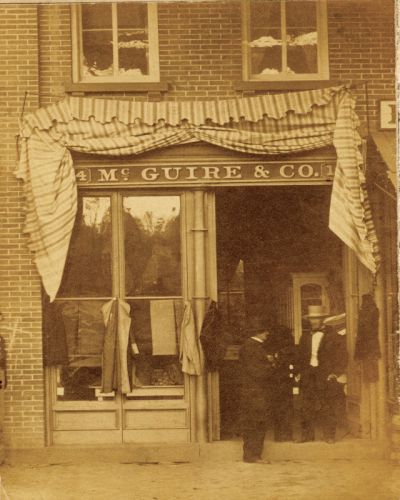
13. James H. Wright, Merchant and Dealer in Gentlemen’s Furnishing Goods. 117–119 Broadway [now 365–367, The Rip Van Dam Hotel]
James Hewlett Wright (ca. 1830–1891) came from New York City in 1855 and worked for Chauncey Hathorn and A.F. Brown for several years. Brown failed in business and Wright took his “stand” in 1858. He was said to be “a very steady and industrious man and an excellent mechanic.” His business was largely made-to-order; in 1865 he reported producing 500 vests and 300 coats worth $15,000 ($278,000 in 2023 dollars), employing five men and four women. He served as village president in 1870 and county treasurer 1875–78. He left Saratoga in 1878.
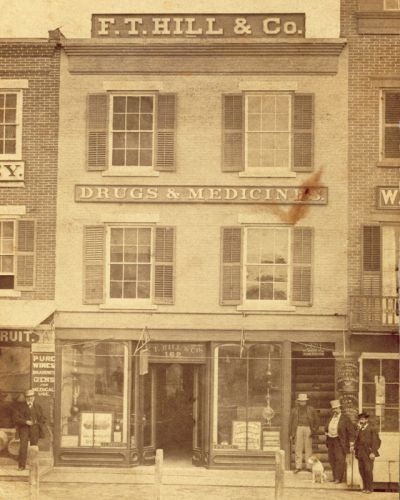
15. A.S. Hays Confectionery and Ice Cream Saloon .165 Broadway [now 425, iRun Local]
Galway native Alexander S. Hays (1825–1899) was in business on Broadway by 1860, an “honest, sober, industrious, attentive, prudent prompt businessman.” His shop may have operated seasonally for the tourist trade as an 1877 report noted he had “suspended trade until the next season.”
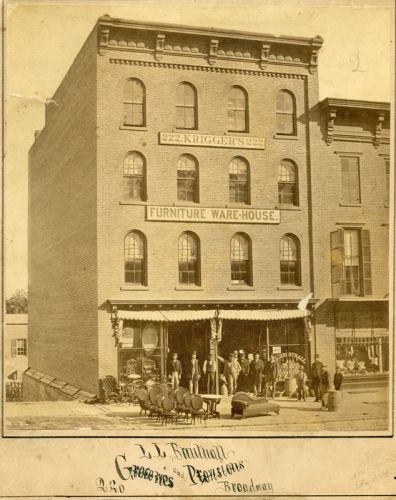
2. Palmer and Waterbury, Dealer in groceries & provisions 208 Broadway ( Now 444, Wheatfields)
Hiram Palmer (1825–1909), a Malta native, lost an earlier store to fire in the summer of 1866. He entered into partnership with John Armstrong Waterbury (1839–1916) and soon reopened a new store. The two men were reported to be “men of intelligence and business experience” with a net worth of $26,500, equivalent to $540,000 today. In 1871 Waterbury decided he did not like the business and sold out to Palmer. Waterbury became a musician.
On the building’s upper floors was the furniture warehouse
of George K. Krigger (1831–1889). By 1880 Krigger had removed to Chicago.
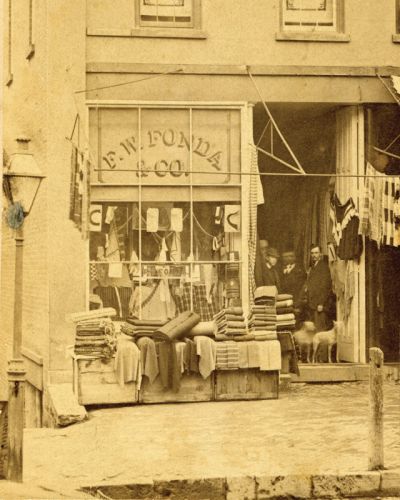
4. Westcott & Smith, Staple & fancy dry goods boots and shoes and groceries 188 Broadway (Now 424, Northshire books)
Warren B. B. Wescott (1820–1899) and Adam A. Smith (1842–1904) were clerking for F.W. Fonda when he failed,
so in 1863 they bought out his stock and entered business. Smith was reported to have “extraordinary business capacity and his character for probity is notorious.” In 1867 they were “doing a fair village and country trade.” They were out of business by 1876.
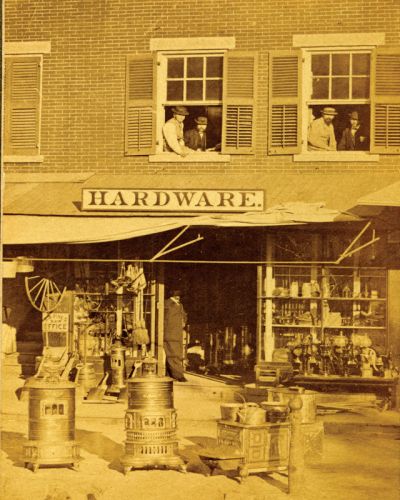
6. A, Hartwell, dealer in harness trunks & saddlery. 172 Broadway (Now 408, Cantina)
Austin Hartwell (1824–1890) was in business here by 1850. He was reported to be a “hardworking man” who was “tolerably honest but is encumbered by a large family and his prospects are not very promising.” He advertised “Saratoga Trunks made to order,” but was out of business by 1870, living in Springfield, Massachusetts.
Note the second-floor sign for the law office of George S. Batcheller who, five years later, built the extraordinary Batcheller Mansion on Circular Street.
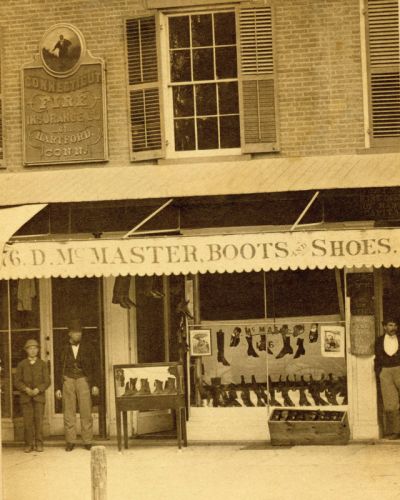
8. J.M Pitney Grocer Brandies Gins and wines. 164 Broadway (Now 402, uncommon grounds)
Jacob W. Pitney (ca. 1817–1894) came from Arlington, Vermont. His brother Jonathan Pitney came as well, establishing a boarding house with a farm to supply fresh produce; today it is Pitney Meadows Community Farm. Jacob was out of business by 1872.
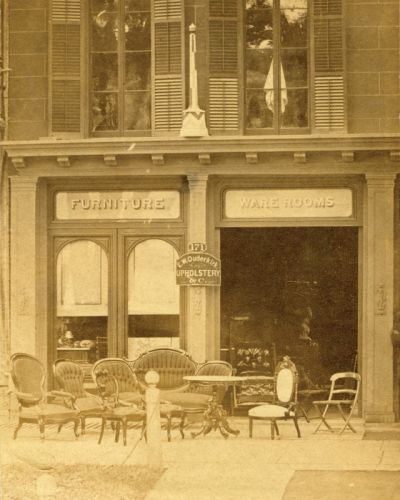
10. A.R Barrett Hat Store, 148 Broadway ( Now 392, Saratoga Saddlery)
New Hampshire native Artemas Raymond Barrett (1815–1904) had been in business on his own since 1844, “a married, honest, prudent businessman” who did “a safe, snug business.” In 1870 it was “the best in his line in the town.” In 1874 he was rebuilding his store “in elegant style.”
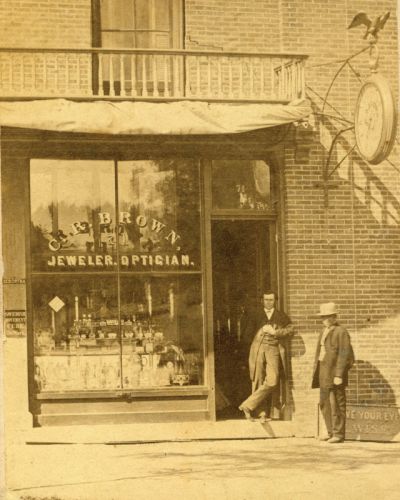
12. M.N McGuire Merchant Tailor and Clothier. 134 Broadway ( Now 380, The Furniture Store).
Irishman Michael N. McGuire (ca. 1822–1870) was in business by 1848. In 1867 he was reported to be “very intemperate and does not attend to his business at all regularly,” but soon was “reformed and doing better.” He failed at business, and it was sold at sheriff’s sale late in 1868. He died of typhoid fever a year later.
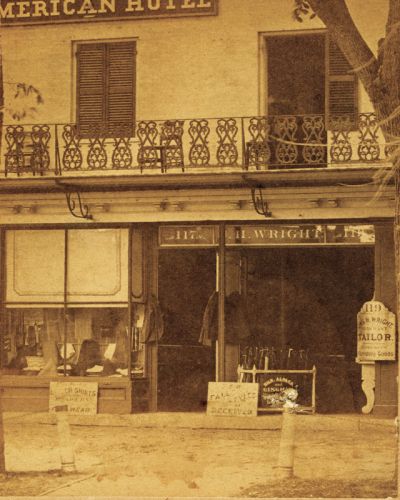
14. F.T. Hill and Company, Wholesale & Retail Druggists & Apothecaries. 162 Broadway [now 400, Uncommon Grounds]
Franklin T. Hill (1819–1875) came from Woodbury, Vermont, and was in business here by 1850. He was reported to be “a strictly honest upright man . . . a man of good repute steady temperate and doing good business.” He also sold U.S. Revenue Stamps, a Civil War-era tax assessment; in 1872 he purchased a soda fountain for his drugstore. When he died he was succeeded by his assistant, T.H. Sands Pennington, an African American druggist who was long a respected Broadway businessman.
